| Volume 19, Issue 9 | September 21, 2017 |
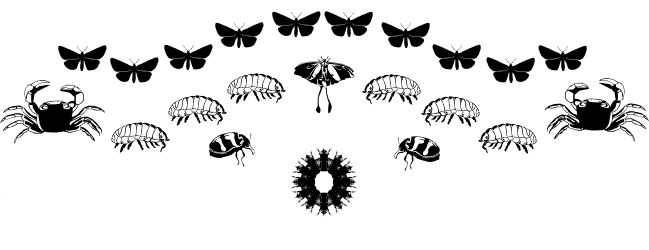
|
In this Issue:
|
| Volume 19, Issue 9 | September 21, 2017 |

|
In this Issue:
|
The small Scandinavian country of Finland has one of the lowest rates of infant mortality in the world (two children under one year of age per 1000 live births). Many in the U.S., with three times that number of infant deaths, are suggesting a widespread program to use a tool Finland's parents have for preventing baby death, small cardboard boxes that help keep the little tikes safely in positions that lower sudden infant death syndrome (SIDS). Could this work here?
The answer is complicated. To a degree, differences in infant mortality stats reflect a measurement of apples vs. oranges. Some countries with lower infant mortality rates, for instance, do not count babies born weighing less than a pound, while typically such kids, often preemies, are factored into the statistics here, though they have much lower chances of survival than babies born later in the mother's pregnancy and with more normal weight and development.
In addition, in Finland there are two major aspects to their success in keeping infant mortality down: the little boxes plus assuring that most mothers-to-be have prenatal screening and medical care. In the U.S. it is true we do not greatly emphasize the special cardboard boxes that, when the children are placed in them, make it easier to avoid SIDS, but perhaps equally or more important, there is not always good access for expectant mothers to prenatal care.
 baby boxes with twins kept safe - Maddie McGravey for NPR - 3-26-17 (npr.org) |
A cardboard box for an infant may seem like a crude, industrial, or impersonal way to treat a tiny baby. However, these boxes have comfortable little cushions, usually are pleasantly decorated, and also can be enhanced with names and pictures of the infant on the exterior. A few states and the District of Columbia have been trying out cardboard box programs for new babies, with generally very welcome results. Parents need not continue to use the boxes and might, for instance, substitute more substantial cribs and beds for the babies. Even in Finland, there has in recent years been a trend away from just using the free-to-parents boxes. Here as there, it appears that the more important factor is that parents receiving them also get educated on the best ways to keep their newborns as safe as possible. Along with the free boxes, if parents learn to avoid putting their babes in places where sleeping siblings or adults might accidentally lie on the infants, where the kids can turn over onto their tummies, or where they might get their faces under blankets or pillows, and if the infants' mothers can get fine prenatal medical or midwifery care, odds are the youngsters will have much better chances of surviving, and our infant mortality rates can be substantially reduced, annually tens of thousands of babies then perhaps being able to grow to maturity as a consequence. What's not to like?
As I am preparing to teach an Audubon Society class on our local butterflies for the fifth year in a row, for the first time I am updating some of the information I will present. The basics, of course, don't really change. Butterflies still lay eggs and nectar at flowers, plus their caterpillars eat plants. However, this class also covers the species likely to be encountered here in Austin and how to identify them. When I led the first class, I had been studying central Texas insects pretty intensely for about ten years, and butterflies are about the most conspicuous group, so I was unlikely to miss them if they were present. I saw patterns in when populations waxed and waned. I noticed which species were consistent and which were unpredictable. I had a pretty good grasp of what was common or rare. Or so I thought.
Then, suddenly, last year was weird. It is not too unusual for southern species to end up here in central Texas, especially late in the year after months of warm weather. But they normally don't appear in large numbers. A small white butterfly called the Common Mestra is, in central Texas, anything but common. It is a tropical species that strays northward from the Rio Grande Valley during the summer and is sometimes seen occasionally in Austin. The fall of 2016, though, was filled with Mestra sightings. It was possible to see dozens at a time as they sought nectar on flowers. They were breeding as well, with caterpillars easily found on the nettle vine, Noseburn, that is their host. This particular population anomaly was fairly easy to explain. We had a winter mild enough for this species to survive in the area, and rainfall/weather conditions were perfect for its host plant. The annoying nettle vine flourished; it bothered us on our early spring hikes but turned out to be just what the Mestras needed to feed lots of hungry caterpillars. A couple of generations over the summer, and the end result was loads of adults.
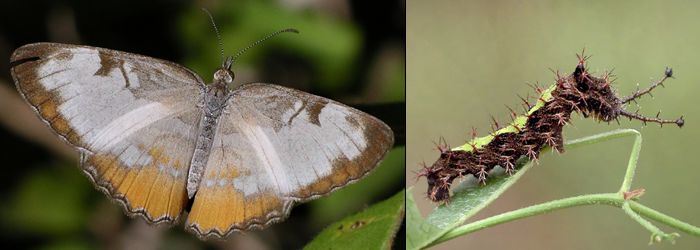 Common Mestra adult & caterpillar |
The Mestra wasn't the only case last year of butterflies invading from the tropics. I had never even seen a Tailed Orange, another Rio Grande Valley resident, until the fall of 2015. I thought I was very lucky to find one here in Austin. However, by the following autumn, they were so common that we saw them all the time. The same thing happened with a couple of white-skipper species. Even a daytime flying moth, the White-tipped Black, found in coastal habitats, showed up in large numbers for a few weeks.
An overly simplistic view could be that global warming is here and southern species are replacing the northern ones. Knowing that almost NOTHING in nature is simple,
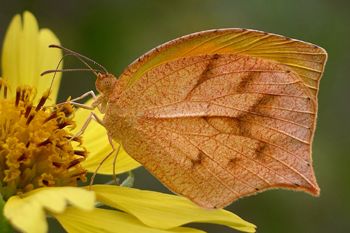 Tailed Orange |
It will be interesting to see if we have an influx of tropical butterflies this coming autumn. This summer was exceptionally devoid of most species, both local and strays. The weather was hot, as usual, but we also had a reasonable amount of rain, so the vegetation is adequate to support both larvae and the nectaring adults. Along with the decline in caterpillars, we've seen a corresponding decline in adults. Yes, there are a few here and there, but numbers and diversity are so low that, on a good day, we might see only ten or so species.
The one butterfly species that has made national news is the Monarch. There is much interest and research going into understanding its population fluctuations and migratory needs and considerations. This is definitely positive in that attention is focused on habitat and other aspects that affect not only one species but the whole faunal community, even if studies do not concentrate explicitly on the big picture. The ecology of a particular region is so complex that we'll never fully grasp all the implications of any single factor. Our observations continue, as do our speculations on cause and effect for any specific phenomenon. The limited perspective from which we must study, measured in decades instead of centuries, is one of the biggest challenges we face. One can never have enough data.
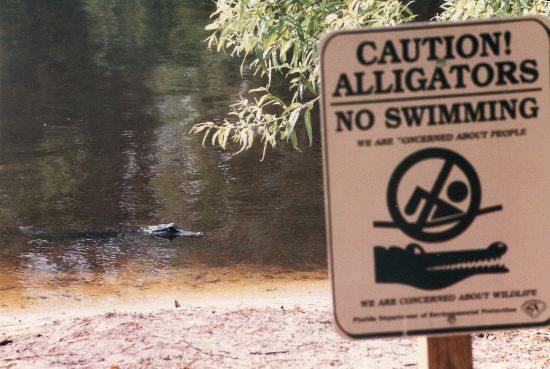
Back before there was Photoshop to facilitate the expression of our humorous tendencies in vacation snapshots, we could still sometimes catch an impromptu serendipitous juxtaposition. The amusingly redundant scene shown above was photographed by Val in Dec., 1997, during a family visit in Florida. Valerie, Larry and their dog, Frisky, spent the Christmas holiday with Val's parents, John and Evelyn, in Ocala. During their stay, they of course took in several of the sights in the area. In the winter months, any sudden cold snap prompts manatees to head for warmer spring-fed waters. At Blue Springs, the large mammals head up a short spring run from the St. John's River to stay warm, sometimes gathering in groups larger than 100. On this particular visit, the manatees weren't very evident, but other wildlife made the trip enjoyable.
![]()
| (The Terra Tabloid is a venue for the discussion of issues pertaining to the past, present, and future of our planet and human interaction with it.) |
The U.S. fire season used to be mainly during our summer months. As droughts have occurred, temperatures have risen, diseases or insect predation have decimated trees in large areas, natural burning - for instance due to lightning strikes - has been suppressed, the amount of unburned dead material in our forests has increased, and human development has expanded into previously wilderness regions, the challenges have grown in scope, duration, cost, and firefighting hazard. Certain areas, for example in southern CA, even have fires that must now be battled year-round.
All this is having effects beyond the immediate scenes of our current conflagrations. The amount of forest material being burned is on average twice that in the mid-1980s. Smoke is affecting those with asthma and other respiratory conditions not merely nearby but hundreds of miles from the latest fires. Fires, especially but not exclusively in the west, are becoming a perpetual phenomenon both in the Lower 48 and in AK. As firefighting is now often needed in all seasons, our new normal is referred to as the Pyrocene or fires epoch. Just as the Pleistocene was a time when ice covered much of Earth, so these days fires threaten to overwhelm much of the planet. Combustion from fossil fuels and from forests are warming the surface of the globe, so another candidate for our age's name is Thermocene.
Whatever we call this time, insurance rates are going up, government-related costs are skyrocketing, and combating large, out-of-control fires is vying with hurricanes, floods, and other natural events for the most devastating of modern emergencies. In 2015, over 10 million acres (about 15,625 square miles) burned in the U.S. That's an area greater than MA, DE, RI, and the District of Columbia combined. Thus far, the national firefighting scene has been easier in 2017, but is still intense in CA, ID, MT, OR, and WA. Recent wetter winters appeared to offer relief but instead encouraged the growth of sagebrush, rabbitgrass, and cheatgrass, excellent fire fuel. Along with the devastation to forests in such vast areas, there are of course attendant destructions at least temporarily to the ecology, watersheds, and wildlife.
The west's Great Basin evidently has the worst of it, yet other regions are not immune. This year has seen nearly 2 million acres of fires in forests or grasslands of FL, NC, OK, SC, and TX.
The U.S. Forest Service might by rights be called the Fire Service. In 2015, for instance, over half its budget went to fighting fires.
The added frequency and intensity of the fires has also called for beefed up efforts to deal with them and often involves teams of firefighters with their equipment and vehicles going in up to 12 months of each year. More firefighter injuries and deaths are occurring. In a typical year, thousands of buildings are also being destroyed by the blazes.
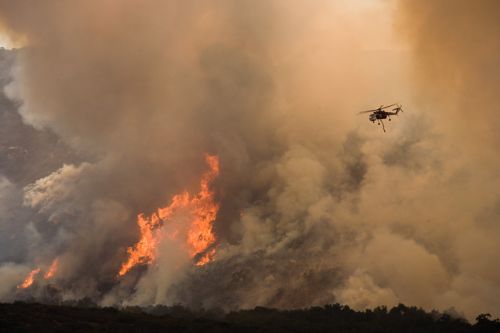 CA Harris fire in 2007 (FEMA) |
With a single, simple source of ignition, be it a thrown out cigarette, a catalytic converter, a campfire not adequately put out, a lightning strike, or the efforts of an arsonist, the right (wrong) combinations of fuel, weather, and topography assure annually many great, fast moving, highly dangerous fires. Such combustion, frequently driven by wind, respects no fences, few roads, and not many structures. Large fires affect nearby weather, especially wind.
They can even jump over streams and can race toward us faster than children, pets, or even adults can run. Just as recent Hurricanes Harvey and Irma forced many to evacuate their homes or seek shelter with minutes or seconds to spare, fires can seem to come from all directions at once and can give potential victims only moments to make life or death choices. Major additional aspects of fire and especially smoke proximity are their adverse effects on our breathing and vision. People die from confusion in a fire setting, not knowing which way to flee, or from smoke inhalation and asphyxiation rather than necessarily from being fatally burned.
As with greater numbers and intensities of severe weather events like tornadoes and hurricanes, more problems can be expected from forest and grassland fires. It appears that for the foreseeable future they will be with us. Metropolitan areas are not free of these hazards. Suburban residential developments can be quickly engulfed in flames.
From personal experience, I have a healthy respect for combustion. As a child I had a couple near tragedies involving fire. Once I thought it would be interesting inside our house to see how quickly a trashcan full of paper flamed up after being lit with one of my matches, then was dismayed to see in seconds it become a roaring torch. I burned by hands and face as I rushed it out to the nearest outside faucet. Another time, I started a little campfire in a big field out behind our house, a former orchard. A few minutes later the wind had caught and spread the flames and almost the whole field plus some of its wooden fencing were engulfed in flames. The volunteer fire department put everything out in time, or it would have burned nearby houses as well. A brother was playing with homemade rockets, from one of which a fire quickly spread over several acres before finally brought under control after several relatives rushed to his aid.
Just as more insects, molds, allergens, diseases, and parasites can move north (and south) into formerly temperate climate zones, the danger and reality of more conflagrations are inevitable as temperatures increase. The importance of dedicated teams of professional and volunteer fighters of these fires has never been greater.
Primary sources:
Longer, Fiercer Fire Seasons the New Normal with Climate Change. Georgina Gustin in insideclimatenews.org; July 11, 2017;
Weather - a Key Ingredient to a Never-Ending "Fire Season." Justin Dombrowski and John Maclean in fema.gov; last updated June 2, 2017.
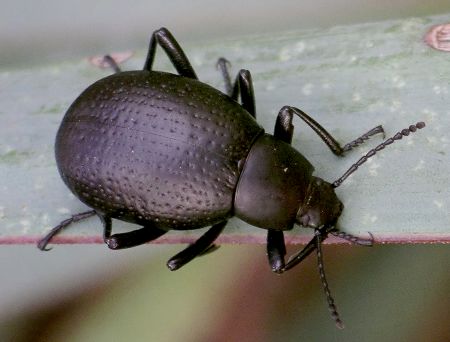
A member of the largest genus in the family Tenebrionidae, the darkling beetle (Eleodes goryi) shown above is one of the most commonly encountered large black beetles here in Austin, but it has no more specific colloquial name. According to researchers, there are somewhere between 200 and 300 species of Eleodes, only the smaller number of which have been formally described. "Desert Stink Beetles" is sometimes used for the genus because 1. they are most diverse in arid regions and 2. some species are capable of squirting a noxious liquid from their rear ends to thwart predators. This particular one, though, does not produce such a chemical defense. In spite of that missing detail, the beetle still performs a characteristic headstand pose as if it COULD spray. It is well adapted to our often dry climate with a very thick exoskeleton and fused wing covers (elytra) that make it flightless but also more resistant to dehydration. This beetle has small jaws and doesn't bite if handled. It is a scavenger and can often be found searching for food on the ground and in low vegetation.
The U.S. stock market is overpriced. A case can certainly be made that it will keep going higher from here, but by historical standards it is already above average per measures of good value. One way to evaluate which companies might do well following an inevitable correction or bear market is by looking at chief executive officer (CEO) pay. Corporate top brass are receiving higher pay packages than ever before. Such large levels of compensation are often at the expense of both shareholders and employees. Studies have in fact shown that companies with higher CEO pay tend to do worse in terms of both profitability and share performance than those with less generous chief executive compensation.
For example, per "Lower Paid CEOs Generate Bigger Returns Than High Flyers: Study," by David Lieberman in deadline.com, July 25, 2016, in a 10-year study reported on in 2016, it was found that among 429 large-cap companies, the CEOs receiving the lowest 20% of compensation provided their shareholders with greater returns than those receiving the highest 20%. The differences were significant, up to 39%, in favor of positive results for lower paid CEO companies. There are other indications as well that, overall, lower pay for the CEOs of publicly traded companies enhances shareholder returns. Of course, the rationale for ever increasing CEO pay is the opposite. Oddly enough, few boards of directors limit their CEOs' pay, possibly suggesting the directors do not have their shareholders' interests in mind but are in league with the CEOs. The latter, of course, provide their salaries.
The pay of a corporate chief executive officer may be viewed in various ways, for instance, the actual dollar amounts of annual pay in relation to CEOs of other roughly equivalent market-cap companies, the ratio of a CEO's pay to that of his or her company's employees, or the percentage of a CEO compensation relative to the company's profitability. By one or more of these standards, the following stock symbols represent companies whose CEOs have recently had well below average levels of pay: AAPL; ADBE; ALXN; ASH; AVP; AXP; BAC; BRK/B; CAT; COF; CPRT; CTXS; EBAY; ELMD; EXPE; FB; FOSL; GOOGL; GRPN; IEP; INTU; KEYS; KHZ; KMI; MCD; MSFT; NATI; NOW; NVDA; ORCL; PYPL; RMAX; SHLD; SNAP; SQ; TSLA; TTWO; URBN; WERN; WFM; YELP; and YHOO.
Investors are invited to use their own criteria to weed from such a list a selection of stocks likely to hold up well for the long-term and, at the right price, adequately reward shareholders.
| Company | Ticker Symbol | Recent Price | Price to Book | Trailing P/E | Debt to Equity | Dividend Yield | Suggested Max. Buy Price |
|---|---|---|---|---|---|---|---|
| Apple, Inc. | AAPL | $158.67 | 6.19 | 18.01 | 0.82 | 1.59% | $127.00 |
| Berkshire Hathaway, Class B shares | BRK/B | $181.47 | 1.49 | 20.53 | 0.34 | 0.00% | $145.00 |
| Intuit, Inc. | INTU | $143.80 | 27.30 | 38.66 | 0.36 | 0.96% | $115.00 |
| Kinder Morgan, Inc. | KMI | $19.39 | 1.23 | 63.99 | 1.06 | 2.59% | $16.00 |
| Oracle Corp. | ORCL | $48.33 | 3.71 | 21.87 | 1.07 | 1.56% | $39.00 |
Personally, I believe our equity market will begin to be attractive again once it has fallen to around 80% of its present level. Markets do not necessarily stop falling just when they get close to fair value, though, so I would not be surprised, once a tumble commences, to see average prices dip significantly more than that before the next bull market might start.
Nonetheless, in looking out across a potential and substantial plummet of share prices, I sought to pick companies likely to be worthwhile after falling at least 20% in price. Those chosen are in the table. In my view, each of these corporations is ably led by a CEO willing to accept less than average pay, at least in relation to company profits. These five, then, AAPL, BRK/B; INTU; KMI; and ORCL, would for me be good companies to own and merit share accumulation once a big market drop is well underway.
Best of luck with your own investing researches and post-bull selections.
| |||||||||
|
Fall arrives tomorrow with the Autumnal Equinox. The North Atlantic hurricane season ignores our seasonal designations and follows its own course, from June through November. It's been a rough one this year, with the extensive damage caused by Harvey, Irma, and Maria. We wish for all those affected by natural disasters the courage to face them and the resources to help them recover.
|
| For others who may have chanced upon this site, larvalbug bytes is a monthly family-and-investment newsletter, put out by an old codger and sweet thing, with sometimes a little help as well from our engaging pooch, Peri. We invite readers' comments by and would also be happy to readers when new issues are published. Articles and stories from back issues are available in our archives. |

|
Copyright © 2017 by LARVALBUG
"Chitin Chorus Line" and larvalbug web design by Valerie.
![]()